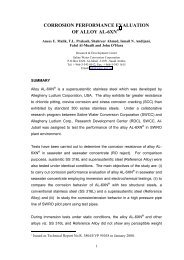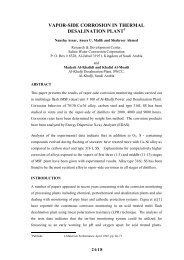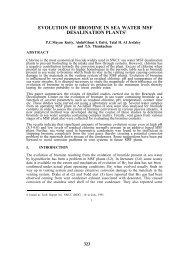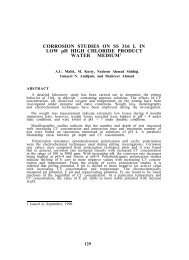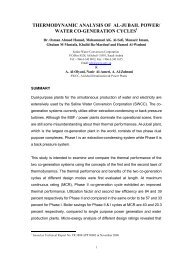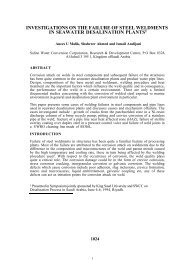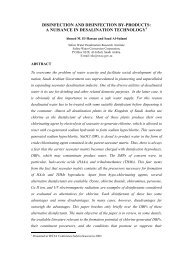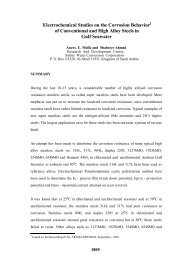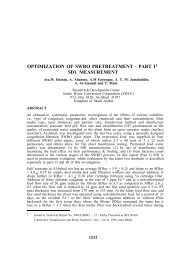impact of interruption of antiscalant dosing or cleaning balls ...
impact of interruption of antiscalant dosing or cleaning balls ...
impact of interruption of antiscalant dosing or cleaning balls ...
You also want an ePaper? Increase the reach of your titles
YUMPU automatically turns print PDFs into web optimized ePapers that Google loves.
Figure 1 reveals that the OHTC and the FF remained virtually constant when the dose<br />
rate <strong>of</strong> the phosphonate based <strong>antiscalant</strong> was reduced in a stepwise mode from 1.0<br />
ppm to 0.4 ppm. Conversely, when the dose rate was reduced further to 0.2 ppm, the<br />
unit started to be fouled and the FF increased from 0.05 to 0.1 m 2 K/kW. When the<br />
<strong>antiscalant</strong> <strong>dosing</strong> was completely stopped, the FF increased significantly from 0.1 to<br />
0.17 m 2 K/kW.<br />
Figure 2 demonstrates that f<strong>or</strong> polycarboxylate based <strong>antiscalant</strong>, the OHTC and FF<br />
during the dose rate range <strong>of</strong> 0.8 ppm down to 0.2 ppm were almost maintained<br />
constant and there was no indication <strong>of</strong> scale f<strong>or</strong>mation. However, when the <strong>antiscalant</strong><br />
<strong>dosing</strong> was completely discontinued, the FF increased significantly from 0.05 to 0.23<br />
m 2 K/kW within three days time.<br />
Comparison <strong>of</strong> the test results depicted in Figures 1 and 2 disclose that phosphonate<br />
and Polycarboxylate based <strong>antiscalant</strong>s will allow pilot plant operation safely down to a<br />
dose rate <strong>of</strong> 0.4 at TBT <strong>of</strong> 90 o C with continuous circulation <strong>of</strong> <strong>cleaning</strong> <strong>balls</strong>.<br />
3.1.1.2 Abrupt Reduction <strong>of</strong> Antiscalant Dose Rate<br />
Two evaluation tests were carried out to determine the <strong>impact</strong> <strong>of</strong> sudden <strong>interruption</strong> <strong>of</strong><br />
<strong>antiscalant</strong> <strong>dosing</strong> on the perf<strong>or</strong>mance <strong>of</strong> the MSF pilot plant. The unit was operated at<br />
a TBT <strong>of</strong> 100 o C, brine concentration ratio <strong>of</strong> 1.4 and with continuous <strong>cleaning</strong> ball<br />
circulation using two different <strong>antiscalant</strong>s. The test results <strong>of</strong> the two examined<br />
<strong>antiscalant</strong>s, which are shown in Figures 3 and 4 disclose that the two <strong>antiscalant</strong>s are<br />
m<strong>or</strong>e <strong>or</strong> less exhibiting the same behavi<strong>or</strong>. The OHTC and the FF <strong>of</strong> the brine heater<br />
were virtually remained constant f<strong>or</strong> a period <strong>of</strong> about 24 hours. Although the<br />
<strong>antiscalant</strong> <strong>dosing</strong> was completely discontinued during this 24 hour period, the residual<br />
quantity <strong>of</strong> <strong>antiscalant</strong> succeeded in suppressing scale f<strong>or</strong>mation. It has been concluded<br />
that if <strong>antiscalant</strong> <strong>dosing</strong> is suddenly interrupted <strong>or</strong> stopped, the pilot plant can safely<br />
operate f<strong>or</strong> a maximum period <strong>of</strong> 24 hours.<br />
In spite that the MSF pilot plant is simulating the operational perf<strong>or</strong>mance <strong>of</strong> a<br />
commercial MSF distiller to a large extent, there are still some operational disparities<br />
between the two units. Particularly the residence time <strong>of</strong> the brine recycle during its



